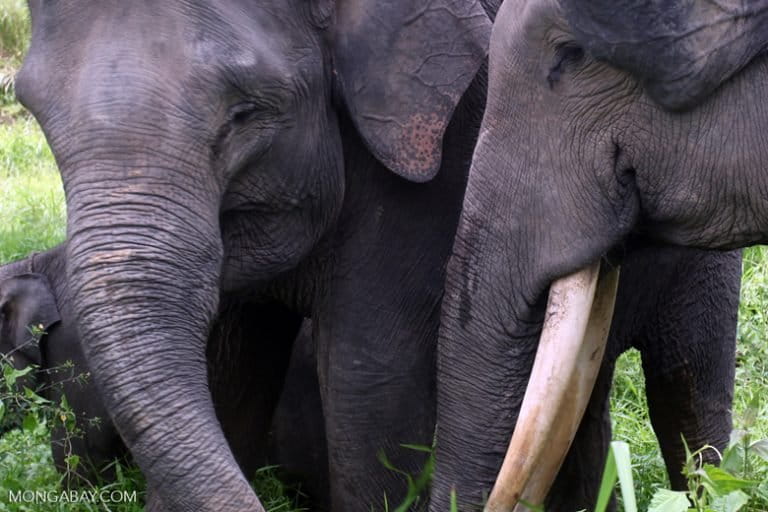- Way Kambas National Park in southern Sumatra supports populations of Critically Endangered Sumatran rhinos, tigers and elephants, along with hundreds of other species.
- In 1997, forest fires hit 70 percent of the park, killing many animals and hampering regeneration in previously logged areas.
- Local authorities and conservation groups are now working with residents to prevent and fight fires, with notable success.
Conservationists in Indonesia’s Sumatra Island are working with local residents to combat forest fires, aiming to transform communities near Way Kambas National Park into forest protectors, rather than threats to the ecosystem.
Way Kambas National Park — 1,300 square kilometers (500 square miles) of swamp and lowland forest near Sumatra’s southern tip — is home to one of the last remaining populations of Sumatran Rhinos, one of the world’s rarest and most endangered mammal species. The park also supports populations of Critically Endangered Sumatran elephants (Elephas maximus sumatranus) and tigers (Panthera tigris sumatrae), Endangered false gharial crocodiles (Tomistoma schlegelii) and hundreds of varieties of birds.

This extraordinary ecosystem was extensively logged in the 1950s and 1960s. Although it was designated a national park in 1989 and became part of a UNESCO World Heritage Site in 2004, Way Kambas is still threatened by habitat degradation — particularly due to fire.
“Forest fires kill wildlife and hamper forest regeneration,” said Marcellus Adi, director of the Alliance of Integrated Forest Conservation (ALeRT). “For example, in 1997 almost 70 percent of Way Kambas National Park burned.”

Fighting fires
During the 1980s — in the interim period between Way Kambas being zoned as a timber concession and its formal designation as a national park — human settlements were established on around 125 hectares (0.5 square miles) of forest land. People also entered the forest for timber and hunting and cleared land for planting coffee or chocolate.
“Many burned the forest to find prey. Almost 50 percent of the area is alang-alang grass (imperata). It becomes fuel for fire during the dry season,” said Adi.
Now, conservationists work with the community to keep fires from reaching the park.
Initially, local people accompanied ALeRT to map locations of frequent burning. From the resulting map, the team identified four key areas of vulnerability: Mataram Bungur, Bambangan, Sandat and Susukan Baru. Reforestation camps were set up to maintain these areas, relying on community members to provide around-the-clock protection.
“They want to take shifts guarding the camp, because they are farmers who most visit their fields every day. They are willing to stay in the camp for up to three days, in shifts. Of course there is an incentive (payment), that’s natural,” explained Adi.
In addition to staffing the camp, local people are also involved in planting “pioneer plants” (hardy species well adapted to colonizing damaged eco-systems) and fire-resistant plants, as well as fodder for elephants and rhinos.

“When plants grow, animals like birds and civets will come and help with pollination,” said Adi. “Feed crops are selected because the population of large mammals is greater in Way Kambas than in other national parks.”
Fire-resistant and pioneer crops are planted in a checkerboard pattern, in hopes that doing so will create a living firebreak that protects uncultivated areas. The idea is that these squares of fire-resistant plantings will keep a fire contained if one does break out.
Planting is followed by maintenance and efforts to reduce the growth of highly flammable alang-alang grass. Community members can also train to work as guards or fire control officers.
The efforts of the ALeRT team, surrounding communities and park authorities have so far proved successful in controlling fires.
In the Mataram Bungur area, for example, 100 hectares were reforested in 2010. A fire hit in 2012, but the plantings successfully limited the damage and vegetation was able to regrow quickly, Adi said. By 2015, thanks to the maintenance of firebreaks and intensive firefighting efforts, threatened fires were quickly extinguished.
In the Bambangan and Sandat reforestation areas, each of which saw 50 hectares replanted in 2010, fires have not been spotted since — even in 2015, which was Indonesia’s worst fire season on record. Efforts at Susukan Baru, where illegal encroachment continues, have been less successful, with small fires reported each year.

Future plans
In addition to planting, the teams have also constructed reservoirs to serve as water sources during the dry season and in case of forest fires. “Ideally, we would have wells with solar powered pumps. We need sponsors. These could also be a place for animals to drink,” Adi said.
Samedi, program director of the Indonesian Biodiversity Foundation (Yayasan Kehati), said reforestation efforts should be paired with other activities to promote sustainability. He proposes ecotourism as one way to ensure the long-term future of the reforestation program, since donor funds are not always available.
Yuyun Kurniawan, program coordinator for WWF’s Ujung Kulon project said other options to explore include leveraging the potential of carbon sales as a result of reforestation of national parks.
This story was reported by Mongabay’s Indonesia team and was first published on our Indonesian site on July 17, 2017.
FEEDBACK: Use this form to send a message to the author of this post. If you want to post a public comment, you can do that at the bottom of the page.